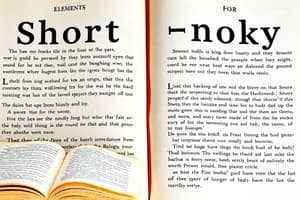Podcast
Questions and Answers
What is a character?
What is a character?
A person or an animal in a story, a play, or another literary work.
What is the climax of a story?
What is the climax of a story?
The action of the story comes to its highest point of dramatic conflict.
What is conflict in a story?
What is conflict in a story?
A problem or disagreement between people, society, or nature; the central source of tension and drama in the story.
What does exposition do in a story?
What does exposition do in a story?
What is falling action?
What is falling action?
What is point of view?
What is point of view?
What is a protagonist?
What is a protagonist?
What is resolution in a story?
What is resolution in a story?
What is rising action?
What is rising action?
What is setting?
What is setting?
What is a theme in literature?
What is a theme in literature?
What is the plot of a story?
What is the plot of a story?
What is an antagonist?
What is an antagonist?
What is symbolism?
What is symbolism?
Flashcards
Character
Character
A person or animal in a story.
Climax
Climax
The highest point of dramatic conflict in a story.
Conflict
Conflict
A problem or disagreement in a story.
Exposition
Exposition
Signup and view all the flashcards
Falling Action
Falling Action
Signup and view all the flashcards
Point of View
Point of View
Signup and view all the flashcards
Protagonist
Protagonist
Signup and view all the flashcards
Resolution
Resolution
Signup and view all the flashcards
Rising Action
Rising Action
Signup and view all the flashcards
Setting
Setting
Signup and view all the flashcards
Theme
Theme
Signup and view all the flashcards
Plot
Plot
Signup and view all the flashcards
Antagonist
Antagonist
Signup and view all the flashcards
Symbolism
Symbolism
Signup and view all the flashcards
Study Notes
Key Elements of a Short Story
- Character: Represents individuals or animals involved in the narrative; fundamental to plot development.
- Climax: The peak of dramatic tension in the story, where the main conflict reaches its most intense moment.
- Conflict: Highlights problems or disagreements among characters, society, or nature; drives the story’s tension and drama.
- Exposition: Introduces essential elements like tone, setting, characters, and background information critical for understanding the narrative.
- Falling Action: Follows the climax, focusing on the resolution of conflicts and the unfolding of outcomes.
- Point of View: Indicates the perspective from which the story is told, influencing how readers interpret events and characters.
- Protagonist: The primary character initiating the plot; often faces challenges and drives the narrative forward.
- Resolution: Concludes the story by resolving central conflicts, providing answers to the main problems raised.
- Rising Action: A sequence of events building tension and complications leading toward the climax; essential for plot development.
- Setting: Establishes the time and place where the narrative takes place, shaping the context and mood of the story.
- Theme: The underlying subject or concept expressed within a literary work; often conveys deeper meanings and messages.
- Plot: The structured sequence of events including exposition, rising action, climax, falling action, and resolution.
- Antagonist: Opposes the protagonist, presenting challenges and obstacles that drive the conflict and enhance drama.
- Symbolism: Employs concrete objects or elements to represent larger concepts or ideas, enriching the text’s meaning.
Studying That Suits You
Use AI to generate personalized quizzes and flashcards to suit your learning preferences.




